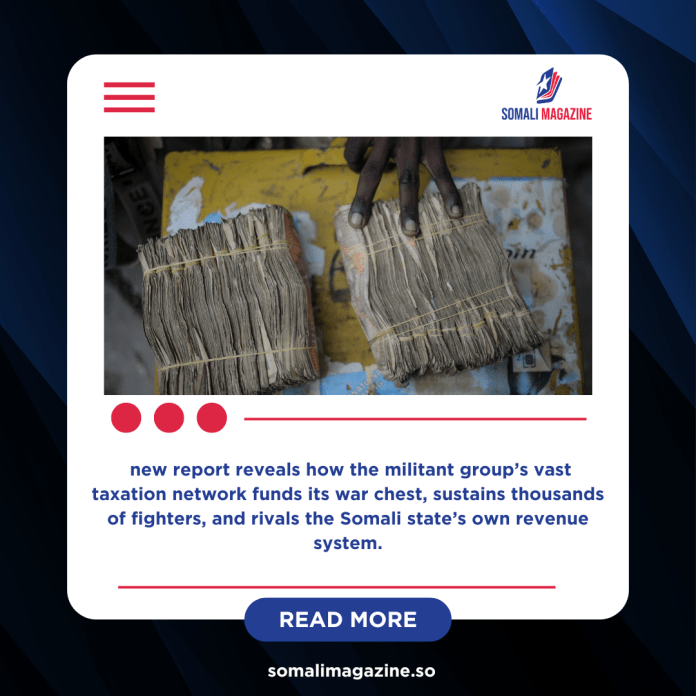Facebook Twitter (X) Instagram Somali Magazine - People's Magazine
Al-Shabaab has become the main financial lifeline for al-Qaida, bringing in up to $200 million every year through forced taxation, extortion, and illegal trade to fund its military operations in Somalia. According to a new report by the Combating Terrorism Center (CTC) at West Point, the group is now the wealthiest branch of al-Qaida, using its money to maintain an army of nearly 18,000 fighters and reclaim strategic towns despite heavy military pressure.
The report, titled The Global State of al-Qa`ida 24 Years After 9/11, explains that al-Shabaab’s financial network is sophisticated and deeply entrenched in Somalia’s economy. Much of its money comes from a parallel taxation system that rivals or even outperforms that of the Somali government. Traders, farmers, herders, transporters, and importers are forced to pay fees disguised as religious alms or business taxes in order to continue their activities. Businesses comply either out of fear of punishment or because paying al-Shabaab is often more predictable than dealing with the state.
Through this system, al-Shabaab has managed to operate like a shadow government, collecting revenue more consistently than official authorities. The group’s financial discipline allows it to pay fighters, buy weapons, and organize large-scale military campaigns. It has also enabled the militants to re-establish control in parts of central and southern Somalia, including the strategic town of Adan Yabaal, northeast of Mogadishu. This town, once held by government forces, now serves as a logistical hub for fighters, weapons, and supplies, strengthening al-Shabaab’s grip on key routes between the capital and central regions.
The report highlights how the group’s growing financial power has exposed the weaknesses of Somalia’s military operations. Despite support from African Union forces and clan militias, Somali troops often struggle to hold onto areas they recapture. Supply lines remain stretched, and government gains are quickly reversed. This has allowed al-Shabaab to intensify attacks in Middle Shabelle and Galmudug, reversing progress made during President Hassan Sheikh Mohamud’s 2022 offensive.
The U.S. has conducted more than 70 airstrikes in Somalia this year, targeting al-Shabaab leaders and training camps. In addition, the U.S.-Gulf Terrorist Financing Targeting Center sanctioned 15 Somali financiers in April, freezing assets linked to the group’s trade and money transfer networks. Meanwhile, Somali authorities have increased efforts to cut off al-Shabaab’s financial flows. The Central Bank has tightened rules for hawalas—informal money transfer networks—and required them to register under anti-money laundering laws. The Financial Reporting Center, together with law enforcement, has frozen hundreds of accounts belonging to suspected al-Shabaab tax collectors and intermediaries. The Attorney General’s Office has also launched prosecutions for terror financing.
Even with these measures, ordinary Somalis remain caught in the middle. In cities like Beledweyne, Baidoa, and along the Mogadishu–Belet Weyne corridor, traders complain of being forced to pay multiple overlapping fees—some to the government, others to clan militias, and still more to al-Shabaab. The militants enforce their demands through intimidation and threats, leaving people with little choice. Livestock, charcoal, exports, and even cuts from diaspora remittances have become steady income streams for the group, ensuring a constant flow of hard currency to fuel its operations.
The CTC report warns that as Western governments shift their focus toward global power rivalries, African affiliates like al-Shabaab are gaining more operational freedom. While al-Qaida’s central leadership has weakened over the years, al-Shabaab’s ability to raise and manage large amounts of money has made it the anchor of al-Qaida’s global network. Financing, the report concludes, has become the backbone of the group’s survival and its war effort in Somalia.

